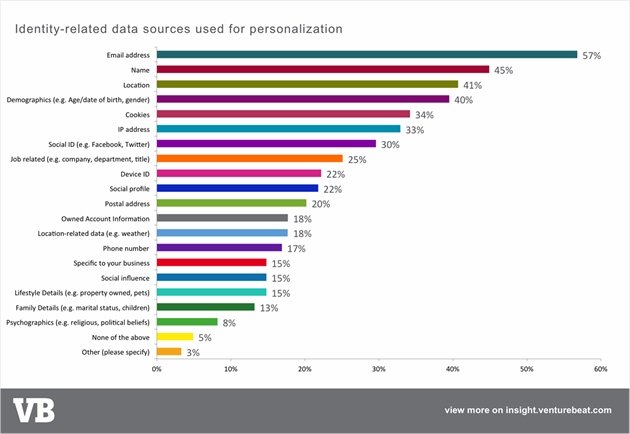
The power of personalization is no secret to marketers today. Today’s consumers have come to expect—if not demand—laser-like precision in the messages that brands are delivering to them.
Unfortunately, message personalization is often used to refer to tactics such as putting a customer’s name in the subject line of an email or adjusting the send time to the user’s location.
Personalization has become a buzzword in marketing, but in most cases what’s being used is easily captured demographic and geographic data:
True personalization is about so much more. It’s about understanding the behavior of your customers, then tailoring your messaging around that behavior.
Let’s take an example. Say your product is a dating website. You know that if someone doesn’t upload his photo, he stands a very poor chance of generating romantic inquiries. Crafting an email around getting people to take that one particular step of uploading a photo is a very good idea. Messaging personalization really comes to life when you use such real-time behavioral data.
Targeting your messages to your customer’s behavior might be harder than slapping a “Hey $FNAME” to an email before it heads out the door, but get it right… and you’ll be well on your way to a one-on-one relationship with each consumer that leads to long-term loyalty.
Here’s my best-practice advice to getting behavior-based messaging right.
1. Decide which behaviors warrant a message
Not all behaviors are created equal. It’s up to you to figure out what behaviors the user takes (or doesn’t take) that are worthy of sending a message. To again use the dating website example from earlier, the behavior in question could be creating a profile or sending five messages.
If you’re unsure what these important actions look like, start by defining your ideal end state: What does a successful customer look like? What steps do they need to complete before they can be successful? Those are the actions you need to encourage in your customers
2. Prioritize the behaviors
Just because a message you send is personal doesn’t mean it’s of value to your customers.
For example, let’s say you’ve just signed up for that cool new productivity app on Product Hunt, invited your first teammate, created your first to-do list, and uploaded your first file all in the space of 30 minutes. And like a configuration of falling dominoes, a series of messages hits your inbox in a predetermined order until they run out—and you unsubscribe.
Does it make sense to attack your customer’s inbox with messages for every single action the customer takes? Of course it doesn’t.
To make sure your messages are relevant and timely, have a clear priority for your behavior-based messages. Perhaps customers will receive a welcome email, but you’ll leave them alone for the next few days if they’re making good progress.
In general, I recommend leaving at least two days between each message to avoid overwhelming your users.
3. Understand the customer’s entire lifecycle
Having data around the actions that people take in relation to your product is among the most powerful kind of information you can have. But it tells only one part of the story. To deliver meaningful one-to-one personalization at scale, you need to use the many context signals at your disposal.
Let’s say you own a collaboration app and a customer has taken one of your product’s most important actions: completed his first project. A perfectly adequate message to send here would be “Congratulations on setting up your first project—keep it up.” But you can do better.
Ask yourself: What else do we know about this customer?
- Has he opened previous messages?
- Has he visited the knowledge base before?
- What size company is he from?
- Has he opted out of marketing communications?
The above are but a handful of signals that, along with usage data, can help us deliver messages that are laser-focused in their accuracy. For example, if you’re speaking to a high-value customer who has contacted customer support several times already this month, your message will have to reflect that.
* * *
Personalizing your messaging correctly is at the core of a sound—and scalable—customer-engagement strategy. The idea of a “spray and pray” messaging strategy is ancient history, whether you’re a startup just hitting your stride or a large company swimming in inbound inquiries.
The good news is that once you’ve properly got to grips with behavior-based messaging, sitting down to write the perfect message becomes much easier.

